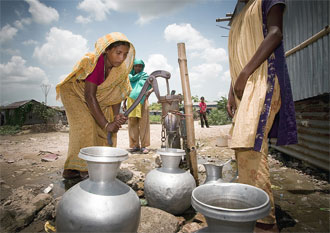Isa earns a hard living pushing a heavy water cart around the rutted streets of the suburbs of Nigeria’s capital, Abuja.
He is one of tens of thousands of water vendors who deliver jerry cans full of water to houses built without any kind of sanitation.
“Kai! it is hard work, pushing my cart,” the 20-year-old says.
Nigeria is Africa’s most populous nation, and according to analysts has made over $1.1 trillion in revenues from the oil industry over the last 30 years; but most Nigerians still rely on people like Isa for their water.
He and a dozen of his friends sleep in a makeshift shelter behind a small household goods shop.
They wake before dawn to queue up at a nearby borehole, where they fill 14 yellow 25-litre jerry cans on their handcarts before setting off around the streets looking for customers.
Heavy load
Fully loaded, the carts weigh at least 350kgs.
The roads they push them over are dirt tracks, rocky and pitted, with sewers running down the middle.
“In the future I want to get another job, but at least I make enough money to live doing this,” Isa says.
The urban poor pay more for water than the urban rich
Prices for water from private boreholes vary in the suburbs.
Isa pays around 10 naira ($0.07, £0.05) per jerry can at the borehole and sells for double that.
He makes around 700 naira a day ($4.70, £3.20), to cover food and living costs.
A large Nigerian family may need around 10 of these jerry-cans every day, customers say.
That adds up to about $486 (£339) every year, a massive pressure on a country where the average person lives on $2 a day.
This is a pattern repeated around the world, according to the UN Development Programme.
The urban poor in developing world cities including Abuja pay much more for their water than citizens of rich cities such as New York or Tokyo, precisely because the poor have to depend on private providers rather a piped municipal supply.
Government failure
Virtually none of the suburbs of Nigeria’s capital city have what is known here as “pipe-born water” provided by the government.
Private individuals have to drill boreholes for themselves.
They are most often fitted with two sets of taps – one for the household, and another facing the street so the owners can make a bit of money on the side.
John, a 25-year-old borehole manager, says the place he looks after in Nyanya Gwandara earns his boss 7,000 naira ($47, £32) a day.
We cannot wait for the government to do anything, we are relying on other wealthy people to dig boreholes.
“The man is from Kogi State where he lives, far away. He dug several boreholes in this area for an investment,” he says.
His customers are grateful.
“We cannot wait for the government to do anything, we are relying on other wealthy people to dig boreholes,” says Janet Daniels, who lives in the area.
She cannot afford to buy the water from the delivery boys, so comes every morning to the borehole to save money.
She fills two 20-litre buckets every morning and carries them on her head back to her home.
“I have to boil the water that we drink because its a very shallow borehole, and sometimes its got little particles of stuff in it.”
Otherwise the quality of the water from here is ok, she says.
Husseini, another water vendor working at a borehole in Nyanya Gwandara, says people like the water from this hole, and he even charges more for it on his rounds.
Scummy rivulets
But other water vendors try and find free sources of water like streams and ponds.
These scummy rivulets are often fed by the sewer-streams that run through the middle of the streets. Diseases like polio, cholera and other types of gastric infection disproportionately affect those in poverty, who get water from bad streams.
Abuja, like other cities in Nigeria, is rapidly growing.
The government has fallen so far behind in providing water here, it may never catch up.
Over the last year the price of a jerry-can of water has doubled.
These problems will only get more acute, and the price of water will only go up.





